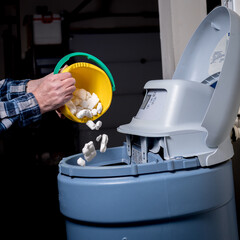A Water Softener is a device used to remove calcium and magnesium ions from hard water. It also removes certain metal cations. Water Softeners Boise reduce the need for soap in cleaning, as fewer soap bonds with calcium ions. This can make cleaning easier and save money on detergent.

A water softener is a device that changes the minerals in hard water into softer forms. This process is called ion exchange, and it removes magnesium and calcium from the water. It does so by replacing them with sodium ions, which do not precipitate out in pipes or react with soap. The amount of sodium added is small-about 12.5 milligrams per 8-ounce glass, which is well below the FDA’s standard of “very low sodium.” However, people with concerns about sodium in their water should consult their doctor before using softeners.
A water softener can be an excellent option for people with very hard water. Hard water can lead to corrosion and other problems in appliances and plumbing systems. It can also make washing clothes and hair difficult. It can also damage your piping system and raise your water bill. A water softener can help reduce these problems while also reducing the amount of water you use in your home.
A water softener will remove hard water minerals from water in a number of ways. Soft water is easier on plumbing and makes cleaning products more effective. It can also reduce the amount of soap you use in your home, and your clothes and dishes will be brighter and less stained. A water softener can also help keep your appliances from scaling, which can make them inefficient and decrease their lifespan.
A mineral tank water softener works by flushing hard water and its minerals away with a solution of salt. The salts force the beads to release magnesium, calcium, and sodium ions, and these minerals move to the drain. After the salts are purged from the system, the unit goes through a three-phase regenerating cycle. The first phase, called backwash, reverses water flow through the tank to flush any dirt or other debris. The second phase, called recharge, involves pumping a concentrated sodium-rich salt solution from the brine tank through the mineral tank.
Water softeners work by rinsing resin beads in a saltwater solution, which removes hardness minerals from water. The solution, which is a mixture of sodium chloride and potassium chloride, regenerates the water softener. As the water passes through the mineral tank, calcium and magnesium ions replace the negatively charged sodium and potassium ions on the resin. The water then passes through the softener’s distribution tube.
Besides the mineral tank, a water softener system also includes a brine tank, which aids the softening process. This tank is located adjacent to the mineral tank and holds a high-concentrated solution of sodium and potassium. This solution helps the resin beads restore their positive charge. This solution is usually added in the form of pellets, which dissolve in the water at the bottom of the tank. A control valve then draws this solution out through the resin and salt in the mineral tank. If the brine tank runs out of salt, the water softener will stop working.
Water softeners use beads to soften water. Beads are made from polystyrene and crisscrossed strands of Divinylbenzene. The number of links determines the durability and strength of the bead. Most modern softeners use beads with an 8% cross-link resin.
Beads remove the hardness minerals in water using ion exchange. They work by exchanging calcium and magnesium ions with sodium and chloride ions in water. The ions then stick to the resin beads. If you want to remove hardness and keep your water soft, you need a water softener that has high ionic exchange capability.
Conventional water softeners work by sending water down into a resin bed without regulating the flow. This means that most of the softening take place at the top of the resin bed, leaving the beads at the bottom unused. This process also increases the sodium level in the water, which can cause health issues, especially in people with high blood pressure. Furthermore, it can also lead to rust in water pipes.
Besides the high concentration of chlorine, another major cause of resin bed degradation is iron. Iron-contaminated resin beads cannot effectively exchange minerals with hardness minerals. Instead, it coats the beads and makes them less effective.